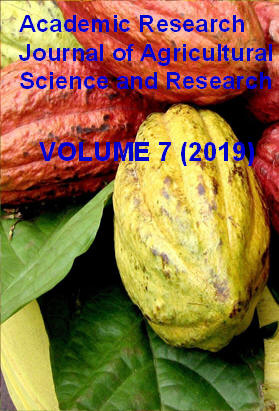|
ISSN: 2360-7874 |
Academic Research Journal of
Agricultural Science and Research |
|||||||||||||||||||
|
Vol. 7(4), pp. 190-201, May 2019 Full Length Research AMMI and GGE bipolt analysis of Genotype x Environment Interaction and Yield Stability of Pearl Millet Genotypes [Pennisetum glaucum (L.) R. Br.] in Moisture Stressed Areas of Ethiopia
Amare Seyoum, Zigale Semahegn and Adane Gebreyohannes
Ethiopian Institute of Agricultural Research, Melkassa Agricultiral Research Center, National Sorghum and Millet research program. *Corresponding Author: seyoumamare99@gmail.com , P.O. Box 436, Adama
Accepted 3 May 2019
The yield performance of crop varieties is highly affected by genotype x environment interaction, which is the major concern to plant breeders while developing improved varieties. In Ethiopia, high yielding and stable pearl millet varieties that withstand drought in the dry lowland areas are limited. In view of this, the yield performance of 24 pearl millet genotypes and one standard check were tested at seven environments with the objectives of estimating the magnitude of GxE for grain yield and to identify high yielder and stable genotypes across environments. The experiment was conducted using Randomized Complete Block Design with three replications. The combined analysis of variance across environments showed highly significant (P<0.001) difference among environments, genotypes and significant (P<0.05) interactions for grain yield studied. The result of the combined AMMI analysis of variance showed that the total variation in grain yield was attributed to environment (73.39 %), genotype (5.47 %) and GxE (21.14 %) effects. Based on AMMI and GGE biplot showed that genotypes, SDMV 95032, ICTP8203 and KAT PM 1 showed high yield and they were stable across environments. Therefore, they will be advanced to variety verification trail for evaluation and verification by variety verification committee in the coming cropping season. Whereas , GGE biplot is also revealed that the ideal genotype and ideal environment are Okoa and Mehoni 2014, respectively. Generally, this study showed the importance of testing pearl millet genotypes for their yield and stability across diverse dry lowland areas of Ethiopia.
Key words: Grain yield, Genotypes, Genotype x Environment interaction, Yield stability
How to cite this article (APA Style): Amare S, Zigale S, Adane G (2019). AMMI and GGE bipolt analysis of Genotype x Environment Interaction and Yield Stability of Pearl Millet Genotypes [Pennisetum glaucum (L.) R. Br.] in Moisture Stressed Areas of Ethiopia.. Acad. Res. J. Agri. Sci. Res. 7(4): 190-201
|
|||||||||||||||||||
